2008 FORD SUPER DUTY air condition
[x] Cancel search: air conditionPage 9 of 96

During refueling, it is possible for water-contaminated diesel fuel to be
pumped into your tank. Your vehicle’s fuel system is equipped with a fuel
filter/water separator to remove water from the fuel. The WATER IN
FUEL RTT will illuminate when the ignition is turned to START (as part
of the light function check) and when the FCM/HFCM has a significant
quantity of water in it.
If the light illuminates when the engine is running, stop the vehicle as
soon as safely possible, shut off the engine, then drain the FCM/HFCM.
Refer toDraining the FCM/HFCM and changing the engine and
vehicle fuel filtersin theMaintenance and Specificationschapter of
this supplement for the drain procedure. Allowing water to stay in the
system could result in extensive damage to, or failure of, the fuel
injection system.
Do not drain the water separator while the engine is running.
Fuel may ignite if the separator is drained while the engine is
running or the vehicle is moving.
Engine oil pressure (F-Super
Duty only):
Illuminates when the oil pressure
falls below the normal range. Refer
toEngine oilin theMaintenance
and Specificationschapter for more information.
Engine air filter (F-Super Duty only):
The engine air filter warning
message comes on in the message
center when the air filter restriction
gauge reaches the CHANGE FILTER
mark or if the air filter and/or
housing becomes packed with snow.
If airflow is restricted because of snow ingestion, the indicator will
remain on until snow is cleared from the housing, but the vehicle will
still be functional.
The air filter condition should be verified by inspecting the underhood
restriction gauge; the message is only a secondary indicator. Always use
the underhood restriction gauge to determine when the air filter element
needs to be changed.
2008 Econoline(eco)
Supplement
USA(fus)
Instrument Cluster
9
Page 11 of 96
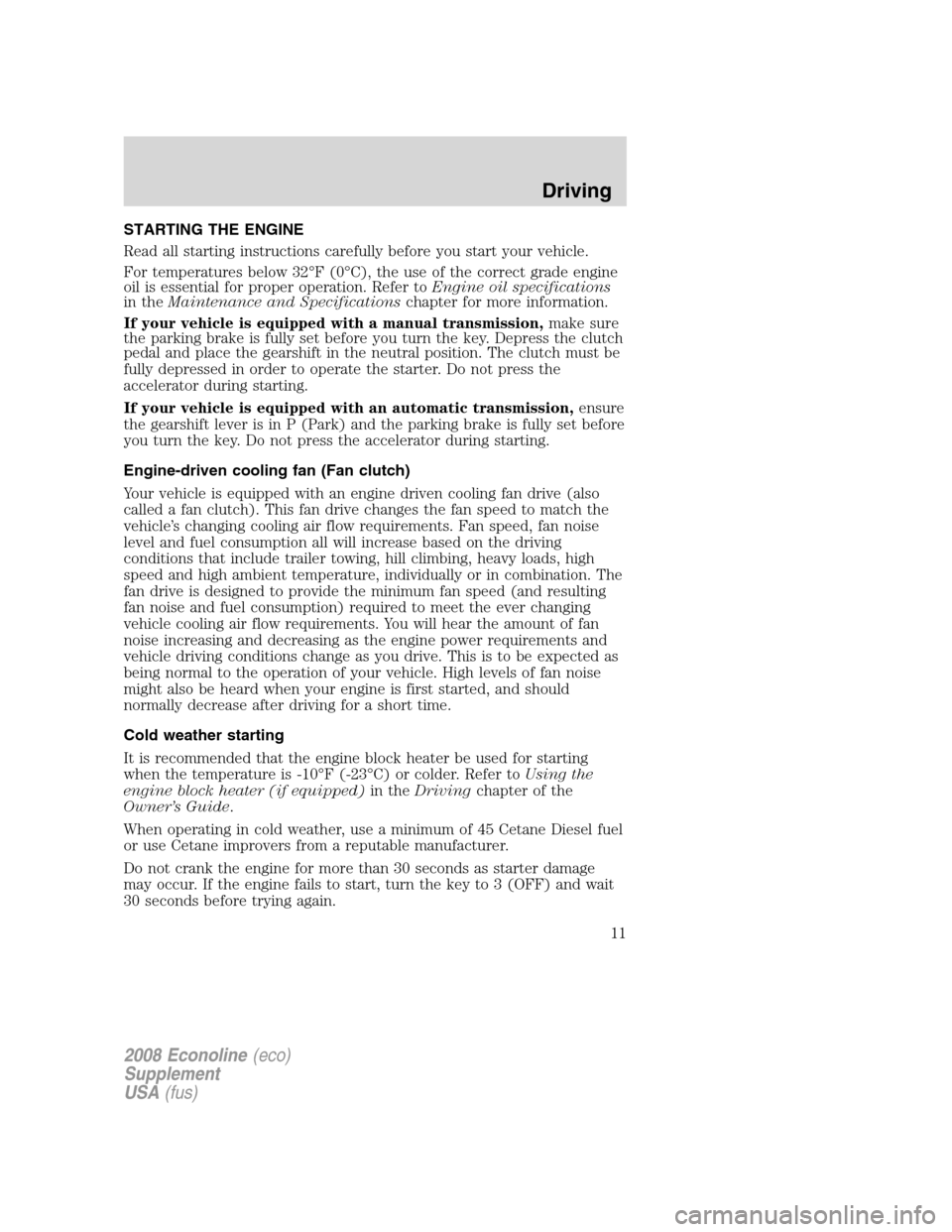
STARTING THE ENGINE
Read all starting instructions carefully before you start your vehicle.
For temperatures below 32°F (0°C), the use of the correct grade engine
oil is essential for proper operation. Refer toEngine oil specifications
in theMaintenance and Specificationschapter for more information.
If your vehicle is equipped with a manual transmission,make sure
the parking brake is fully set before you turn the key. Depress the clutch
pedal and place the gearshift in the neutral position. The clutch must be
fully depressed in order to operate the starter. Do not press the
accelerator during starting.
If your vehicle is equipped with an automatic transmission,ensure
the gearshift lever is in P (Park) and the parking brake is fully set before
you turn the key. Do not press the accelerator during starting.
Engine-driven cooling fan (Fan clutch)
Your vehicle is equipped with an engine driven cooling fan drive (also
called a fan clutch). This fan drive changes the fan speed to match the
vehicle’s changing cooling air flow requirements. Fan speed, fan noise
level and fuel consumption all will increase based on the driving
conditions that include trailer towing, hill climbing, heavy loads, high
speed and high ambient temperature, individually or in combination. The
fan drive is designed to provide the minimum fan speed (and resulting
fan noise and fuel consumption) required to meet the ever changing
vehicle cooling air flow requirements. You will hear the amount of fan
noise increasing and decreasing as the engine power requirements and
vehicle driving conditions change as you drive. This is to be expected as
being normal to the operation of your vehicle. High levels of fan noise
might also be heard when your engine is first started, and should
normally decrease after driving for a short time.
Cold weather starting
It is recommended that the engine block heater be used for starting
when the temperature is -10°F (-23°C) or colder. Refer toUsing the
engine block heater (if equipped)in theDrivingchapter of the
Owner’s Guide.
When operating in cold weather, use a minimum of 45 Cetane Diesel fuel
or use Cetane improvers from a reputable manufacturer.
Do not crank the engine for more than 30 seconds as starter damage
may occur. If the engine fails to start, turn the key to 3 (OFF) and wait
30 seconds before trying again.
2008 Econoline(eco)
Supplement
USA(fus)
Driving
11
Page 12 of 96
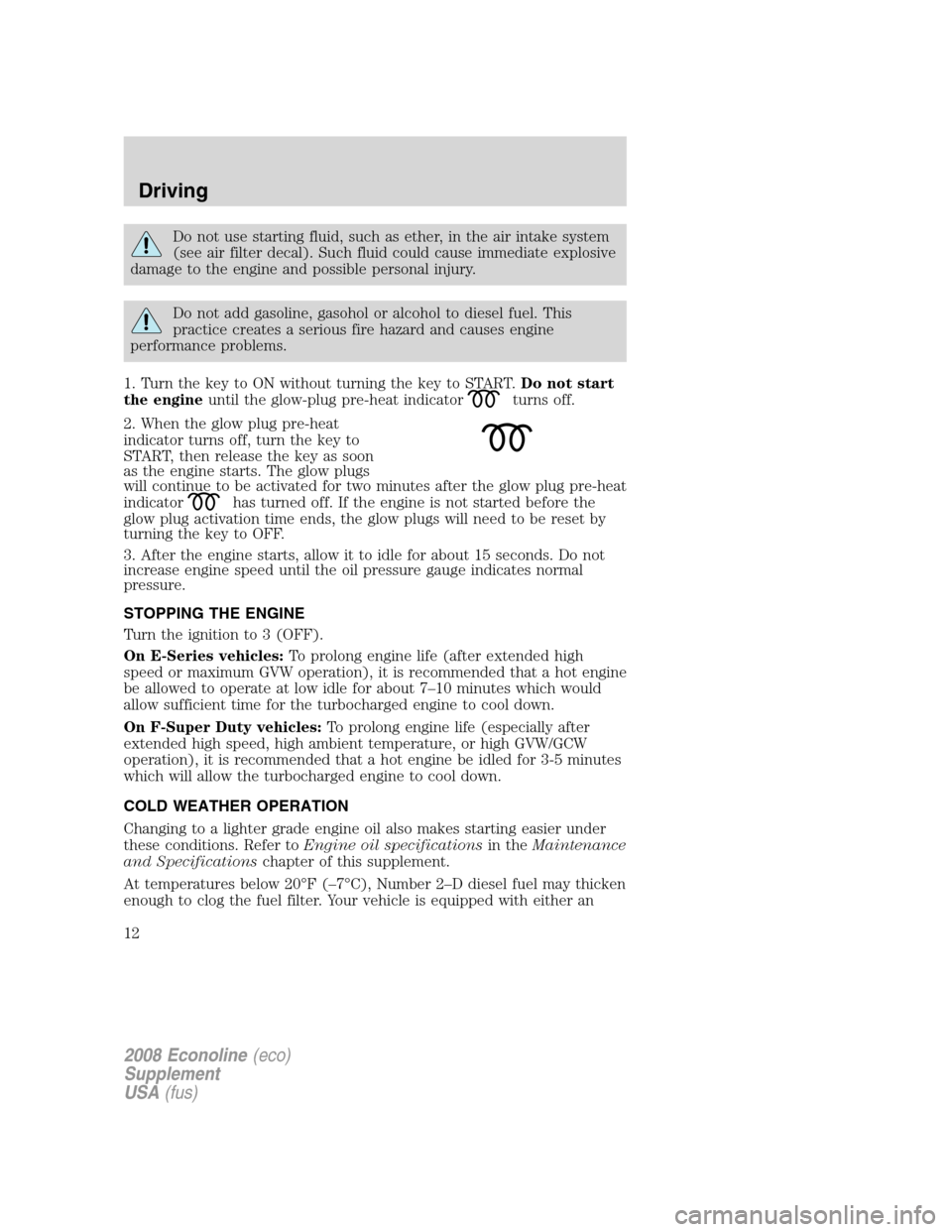
Do not use starting fluid, such as ether, in the air intake system
(see air filter decal). Such fluid could cause immediate explosive
damage to the engine and possible personal injury.
Do not add gasoline, gasohol or alcohol to diesel fuel. This
practice creates a serious fire hazard and causes engine
performance problems.
1. Turn the key to ON without turning the key to START.Do not start
the engineuntil the glow-plug pre-heat indicator
turns off.
2. When the glow plug pre-heat
indicator turns off, turn the key to
START, then release the key as soon
as the engine starts. The glow plugs
will continue to be activated for two minutes after the glow plug pre-heat
indicator
has turned off. If the engine is not started before the
glow plug activation time ends, the glow plugs will need to be reset by
turning the key to OFF.
3. After the engine starts, allow it to idle for about 15 seconds. Do not
increase engine speed until the oil pressure gauge indicates normal
pressure.
STOPPING THE ENGINE
Turn the ignition to 3 (OFF).
On E-Series vehicles:To prolong engine life (after extended high
speed or maximum GVW operation), it is recommended that a hot engine
be allowed to operate at low idle for about 7–10 minutes which would
allow sufficient time for the turbocharged engine to cool down.
On F-Super Duty vehicles:To prolong engine life (especially after
extended high speed, high ambient temperature, or high GVW/GCW
operation), it is recommended that a hot engine be idled for 3-5 minutes
which will allow the turbocharged engine to cool down.
COLD WEATHER OPERATION
Changing to a lighter grade engine oil also makes starting easier under
these conditions. Refer toEngine oil specificationsin theMaintenance
and Specificationschapter of this supplement.
At temperatures below 20°F (–7°C), Number 2–D diesel fuel may thicken
enough to clog the fuel filter. Your vehicle is equipped with either an
2008 Econoline(eco)
Supplement
USA(fus)
Driving
12
Page 13 of 96

FCM (E-Series) or an HFCM (F-Super Duty) which acts as a fuel
filter/water separator to keep the wax melted which will help prevent
fuel filter clogging. However, if the engine starts but stalls after a short
time and will not restart, the fuel filter(s) may be clogged. For best
results in cold weather, use Number 1–D diesel fuel or “winterized”
Number 2–D diesel fuel which has an additive to minimize wax
formation.
Your vehicle is also equipped with a bypass relief valve, located on the
fuel control module, which provides fuel flow to the engine if the fuel
pickup should become plugged by ice or wax. To allow the bypass valve
to function and avoid engine fuel starvation, it is recommended that,
during cold weather operation 32°F (0°C) or below, the fuel level in your
tank should not be allowed to drop below
1�4full. This will help prevent
air from entering the fuel system and stalling the engine.
In cold weather below 32°F (0°C), the engine will slowly increase to a
higher idle speed if left idling in P (Park). As the engine warms-up, the
engine sound level will decrease due to the activation of PCM-controlled
sound reduction features.
If your vehicle is operated in a heavy snow storm or blowing snow
conditions, the engine air induction may become partially clogged with
snow and/or ice. If this occurs, the engine may experience a significant
reduction in power output. At the earliest opportunity, clear all the snow
and/or ice away from inside the air filter assembly. Take the top off the
assembly, leaving the air filter in, and remove any snow or ice.
In order to operate the engine in temperatures of 32°F (0°C) or lower,
read the following instructions:
•Make sure that the batteries are of sufficient size and are fully
charged. Check other electrical components to make sure they are in
optimum condition.
•Use Motorcraft Premium Gold Engine Coolant solution at the
concentration recommended to protect the engine against damage
from freezing.
•Try to keep the fuel tank full as much as possible at the end of
operation to prevent condensation in the fuel system.
•Make sure you use proper cold weather engine oil and that it is at its
proper level. Also, if necessary, make sure to follow the engine oil and
filter change schedule found under theSpecial Operating Conditions
section in theScheduled Maintenance Guidechapter.
•At temperatures of -10°F (-23°C) or below, it is recommended that
you use an engine block heater to improve cold engine starting.
2008 Econoline(eco)
Supplement
USA(fus)
Driving
13
Page 15 of 96
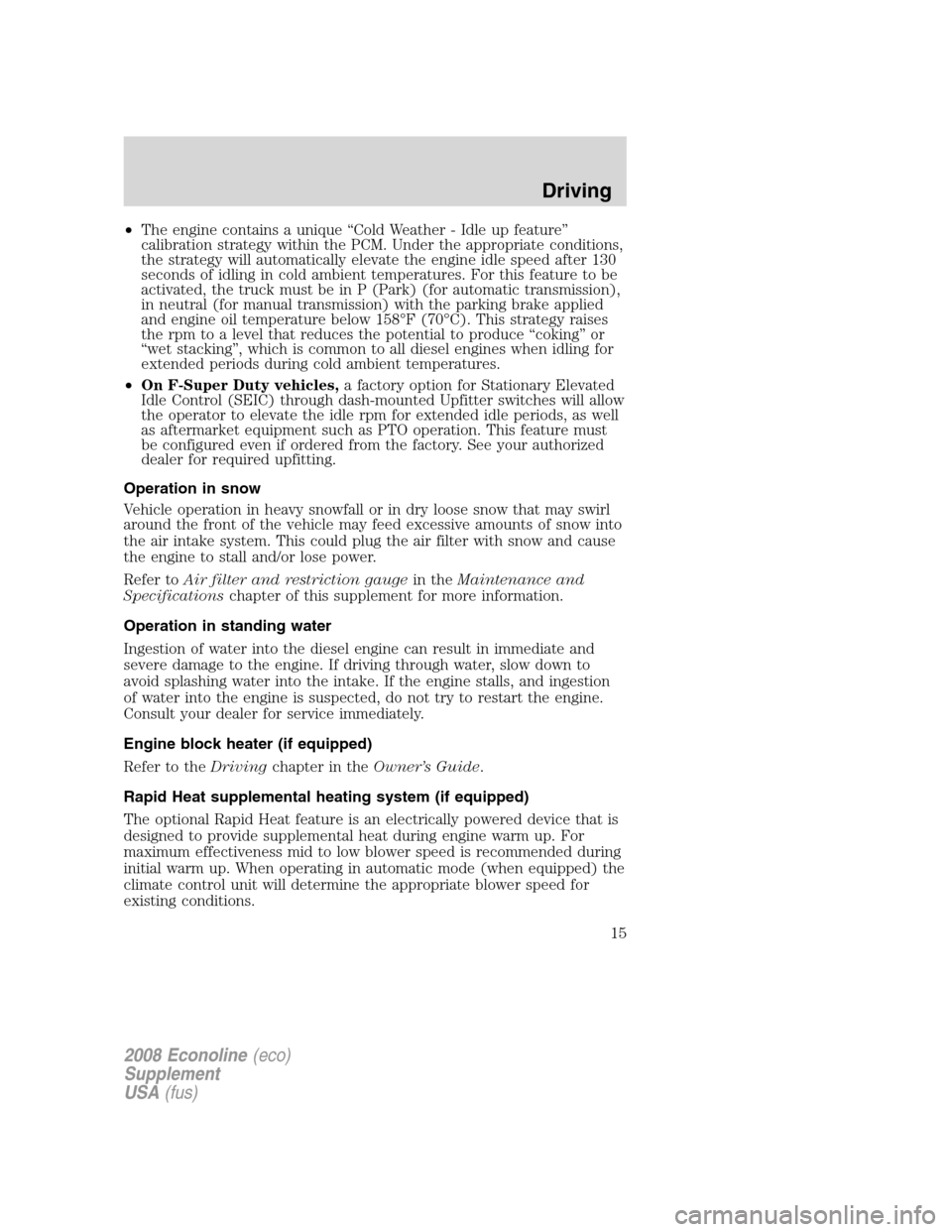
•The engine contains a unique “Cold Weather - Idle up feature”
calibration strategy within the PCM. Under the appropriate conditions,
the strategy will automatically elevate the engine idle speed after 130
seconds of idling in cold ambient temperatures. For this feature to be
activated, the truck must be in P (Park) (for automatic transmission),
in neutral (for manual transmission) with the parking brake applied
and engine oil temperature below 158°F (70°C). This strategy raises
the rpm to a level that reduces the potential to produce “coking” or
“wet stacking”, which is common to all diesel engines when idling for
extended periods during cold ambient temperatures.
•On F-Super Duty vehicles,a factory option for Stationary Elevated
Idle Control (SEIC) through dash-mounted Upfitter switches will allow
the operator to elevate the idle rpm for extended idle periods, as well
as aftermarket equipment such as PTO operation. This feature must
be configured even if ordered from the factory. See your authorized
dealer for required upfitting.
Operation in snow
Vehicle operation in heavy snowfall or in dry loose snow that may swirl
around the front of the vehicle may feed excessive amounts of snow into
the air intake system. This could plug the air filter with snow and cause
the engine to stall and/or lose power.
Refer toAir filter and restriction gaugein theMaintenance and
Specificationschapter of this supplement for more information.
Operation in standing water
Ingestion of water into the diesel engine can result in immediate and
severe damage to the engine. If driving through water, slow down to
avoid splashing water into the intake. If the engine stalls, and ingestion
of water into the engine is suspected, do not try to restart the engine.
Consult your dealer for service immediately.
Engine block heater (if equipped)
Refer to theDrivingchapter in theOwner’s Guide.
Rapid Heat supplemental heating system (if equipped)
The optional Rapid Heat feature is an electrically powered device that is
designed to provide supplemental heat during engine warm up. For
maximum effectiveness mid to low blower speed is recommended during
initial warm up. When operating in automatic mode (when equipped) the
climate control unit will determine the appropriate blower speed for
existing conditions.
2008 Econoline(eco)
Supplement
USA(fus)
Driving
15
Page 28 of 96
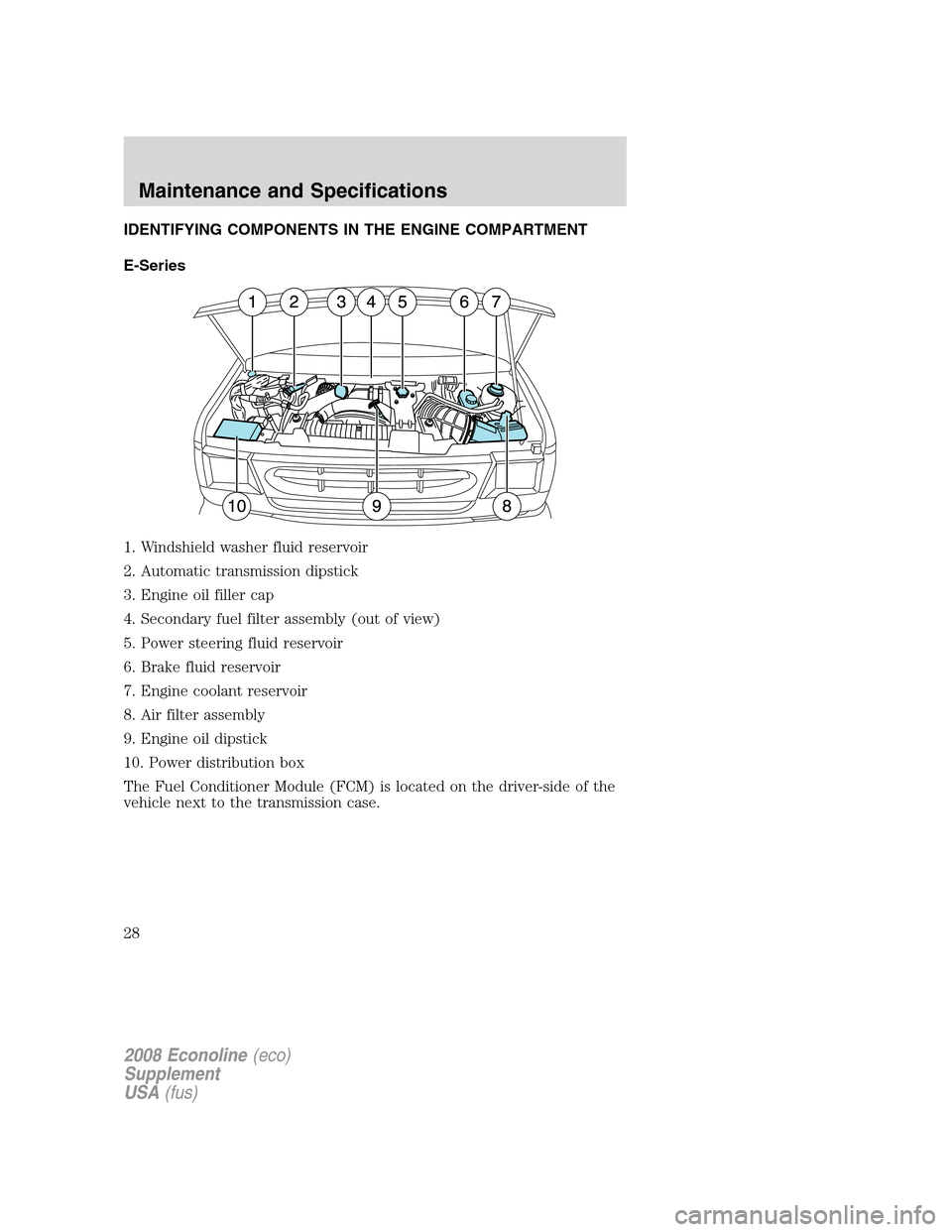
IDENTIFYING COMPONENTS IN THE ENGINE COMPARTMENT
E-Series
1. Windshield washer fluid reservoir
2. Automatic transmission dipstick
3. Engine oil filler cap
4. Secondary fuel filter assembly (out of view)
5. Power steering fluid reservoir
6. Brake fluid reservoir
7. Engine coolant reservoir
8. Air filter assembly
9. Engine oil dipstick
10. Power distribution box
The Fuel Conditioner Module (FCM) is located on the driver-side of the
vehicle next to the transmission case.
2008 Econoline(eco)
Supplement
USA(fus)
Maintenance and Specifications
28
Page 32 of 96
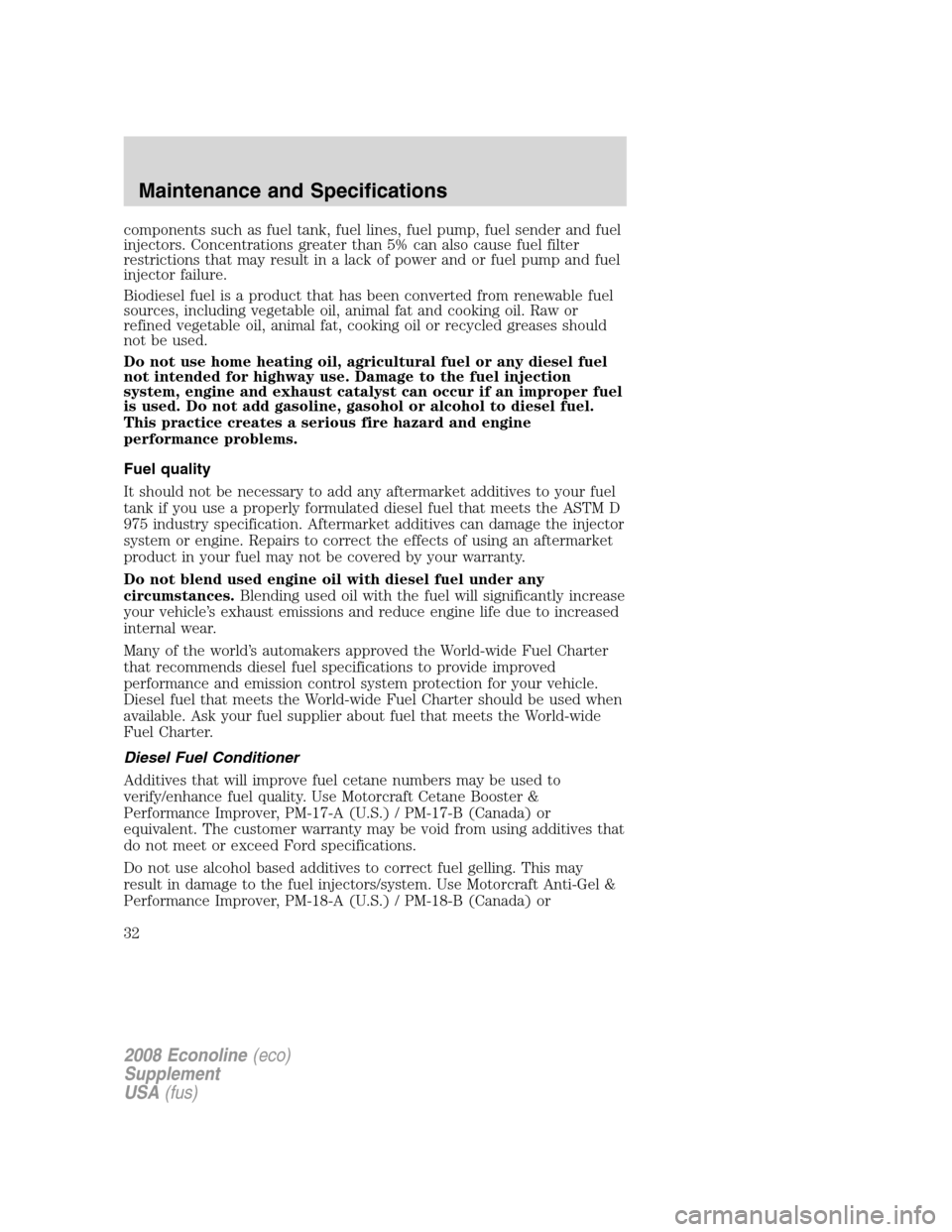
components such as fuel tank, fuel lines, fuel pump, fuel sender and fuel
injectors. Concentrations greater than 5% can also cause fuel filter
restrictions that may result in a lack of power and or fuel pump and fuel
injector failure.
Biodiesel fuel is a product that has been converted from renewable fuel
sources, including vegetable oil, animal fat and cooking oil. Raw or
refined vegetable oil, animal fat, cooking oil or recycled greases should
not be used.
Do not use home heating oil, agricultural fuel or any diesel fuel
not intended for highway use. Damage to the fuel injection
system, engine and exhaust catalyst can occur if an improper fuel
is used. Do not add gasoline, gasohol or alcohol to diesel fuel.
This practice creates a serious fire hazard and engine
performance problems.
Fuel quality
It should not be necessary to add any aftermarket additives to your fuel
tank if you use a properly formulated diesel fuel that meets the ASTM D
975 industry specification. Aftermarket additives can damage the injector
system or engine. Repairs to correct the effects of using an aftermarket
product in your fuel may not be covered by your warranty.
Do not blend used engine oil with diesel fuel under any
circumstances.Blending used oil with the fuel will significantly increase
your vehicle’s exhaust emissions and reduce engine life due to increased
internal wear.
Many of the world’s automakers approved the World-wide Fuel Charter
that recommends diesel fuel specifications to provide improved
performance and emission control system protection for your vehicle.
Diesel fuel that meets the World-wide Fuel Charter should be used when
available. Ask your fuel supplier about fuel that meets the World-wide
Fuel Charter.
Diesel Fuel Conditioner
Additives that will improve fuel cetane numbers may be used to
verify/enhance fuel quality. Use Motorcraft Cetane Booster &
Performance Improver, PM-17-A (U.S.) / PM-17-B (Canada) or
equivalent. The customer warranty may be void from using additives that
do not meet or exceed Ford specifications.
Do not use alcohol based additives to correct fuel gelling. This may
result in damage to the fuel injectors/system. Use Motorcraft Anti-Gel &
Performance Improver, PM-18-A (U.S.) / PM-18-B (Canada) or
2008 Econoline(eco)
Supplement
USA(fus)
Maintenance and Specifications
32
Page 43 of 96

AIR FILTER RESTRICTION GAUGE AND AIR FILTER
REPLACEMENT
Air filter restriction gauge:
The restriction gauge, located on
the upper housing of the air filter
assembly, measures the vacuum
inside the air filter. The more the air
filter is restricted (dirty, clogged),
the higher the vacuum reading
Check the air filter restriction gauge
whenever the hood is raised to
perform general engine maintenance
at least every 7,500 miles (12,000 km). If the vehicle is operated in
extremely dusty conditions, check the gauge at least every 500 miles
(800 km), or two weeks, whichever comes first.
Change the air filter when the gauge reads 25 inches (635 mm). Engine
performance and fuel economy are adversely affected when the
maximum restriction is reached.
Blowing-out the air filter element with compressed air is not
recommended as the compressed air may damage the filter paper.
Note:It is not possible to determine the level of filter clogging by visual
appearance alone. A filter which appears to be dirty may actually have
several thousand miles (kilometers) of life remaining.
Always use the underhood air filter restriction gauge to
determine when the air filter element needs to be changed. The
warning light on the instrument cluster should not be used
exclusively for determining when the air filter element needs
changing.
2008 Econoline(eco)
Supplement
USA(fus)
Maintenance and Specifications
43